Melanoma – what you need to know

According to the American Cancer Society, about more than 100,000 new melanomas will be diagnosed in the U.S. this year. We asked Dr. Ida Orengo, chair of the Department of Dermatology at Baylor College of Medicine, more about this disease and what patients need to know to protect themselves and their loved ones.
“Melanoma arises from the melanocyte cell of the skin, and there are four basic clinical types,” Orengo explained. The first type is superficial spreading melanoma, which is the most common. The second is lentigo maligna melanoma, the one most related to excessive sun exposure. The third is nodular melanoma, the most aggressive, and finally, acral lentiginous melanoma, the rarest and the one that usually affects the feet and hands and toes.
While melanoma can happen to anyone, certain risk factors make people more prone to the disease.
“Patients with blonde or red hair and blue or green eyes usually burn when exposed to the sun and, therefore, are more likely to develop melanoma,” Orengo said. “Also, anyone with a family history of melanoma or those who have had many sunburns are more likely to develop the disease.”
If you notice a mole, Orengo recommends following the ABCDEs of melanoma. You should look for:
- A – Asymmetry of the lesion
- B – border irregularity
- C – Color variegation
- D – diameter >6mm
- E – evolution – lesion that is changing
“I also tell patients that any mole that changes, like growing, bleeding or itching, should be brought to the attention of their physician,” Orengo said.
The simplest way to prevent melanoma is to protect yourself from the sun since it is known that excessive sun exposure leads to the development of melanoma. Ways to protect yourself include avoiding the sun between 10am and 4pm in Houston, applying sunscreen, wearing hats and sunglasses and protective clothing.
There also have been reports that taking various supplements, such as antioxidants, nicotinamide, resveratrol and foods rich in omega-3 fatty acids, may decrease the risk. So, eat fatty fish twice a week with lots of vegetables and drink green tea would be helpful,” Orengo said.
It is also important to see your dermatologist as soon as possible if you notice that a mole is changing or a new mole develops. The earlier melanoma is caught, the greater the chance for cure.
By Anna Kiappes



